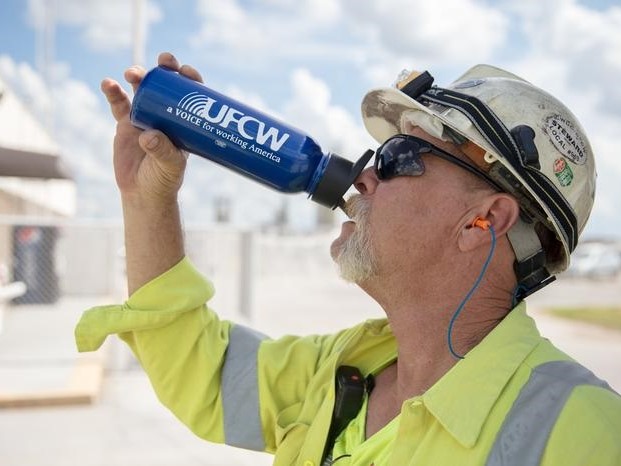The UFCW’s Occupational Safety and Health (OSH) Office has guidelines to help locals protect our members from the risk of heat illness this summer.

To prevent heat illness, employers should make sure all workers have access to:
• Time to acclimatize to the heat. It takes about one week for the body to adjust to working in the heat. New and returning workers should be given time to get used to working in high heat areas. During the first two weeks, they should be monitored for signs of heat illness and provided with extra breaks until they have adjusted to the heat.
• Adequate amounts of cool drinking water.
• Regular rest breaks or rest periods in a designated shady or cool location.
• Regular bathroom breaks, as necessary.
• Increased air circulation through the use of air conditioning, fans and general ventilation.
• Education on the early signs of heat-related illness.
Hot weather safety strategies should include:
• Training all management and hourly employees with an emphasis on how to recognize a medical emergency (heat stroke).
• Having a clearly written protocol on how to respond to a medical emergency.
• Training all management and hourly employees on the right of workers to access drinking water, as needed, and the right to access bathrooms, as needed.
• Monitoring particularly hot work areas and a plan in place for when the heat index approaches the extreme caution zone.
Two major heat-related illnesses are heat exhaustion and heat stroke. Heat exhaustion, if left untreated, may progress to deadly heat stroke. The symptoms of heat exhaustion and heat stroke are listed below:
Symptoms of Heat Exhaustion
- Headache, dizziness or fainting
- Weakness and wet skin
- Irritability or confusion
- Thirst, nausea or vomiting
Symptoms of Heat Stroke
- May be confused, unable to think clearly, pass out, collapse or have seizures (fits)
- May stop sweating
“Summer is upon us again and, as usual, excessive heat is a concern for our members,” said OSH Office Director Roy McAllister. “Identifying the symptoms of excessive heat exposure are important as it can make the difference between someone experiencing heat exhaustion or heat stroke, which can often be fatal. We need to make sure that the employers are providing workers with the correct amount of rest, shade, hydration and a cooling area for workers who are exposed to excessive heat.”
Materials about hydration are available here and OSHA materials about preventing heat stress at work are available in English and Spanish. For more information about heat and heat-related illness, please contact Roy McAllister, the director of the OSH Office, at rmcallister@ufcw.org.
